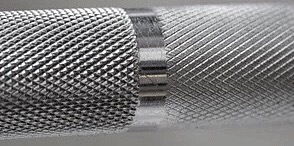Anatomy 101. Barbell part III
We don’t want a medical degree, but to be a good barbell owner, we need to know it’s anatomy.
Let’s look.
Shaft:
The middle of the barbell is called the shaft. It’s where we grab onto in various places for our 4 Core lifts. Here we care about four things. Strength, diameter, the knurling, and the coating.
The strength of a barbell shaft is measured in tensile strength as pounds per square inch(PSI). For all high quality bars, shaft strength should never be an issue for us. Anything at 165K PSI and above will be fine.
Watch out for aluminum training bars, they have very low tensile PSI. They look nice and can still be expensive, but are dangerous to weight train with. So keep an eye on the tensile strength when shopping around.

Men’s bars range from a 28-29mm shaft diameter. The average man will find 28-29mm feels the best. For smaller hands, youth and women’s bars at 25mm may fit better.
Yes, 2-3 millimeters make a major difference in how much you like holding the bar. Actually, you’ll notice a .5-1mm difference.
Unless you have bigger hands, a 30+mm bar may feel bulky and awkward.
Bar shafts have rough areas etched into the steel to increase grip, called knurling.
Knurling can be mild, moderate, or aggressive. Mild knurling is great for olympic lifts. Aggressive knurling is great for power lifters. For us, moderate knurling will secure our grip without feeling like it’s cutting into our hands.

There are knurl marks that are smooth rings at certain spots to follow olympic or powerlifting guidelines. These marks are great as reference points for where you like to hold the bar for each lift.
Some bars have knurling at the center of the bar to help it stick to your back when squatting heavy weights. I’ve squatted 300+ with and without a center knurl on the bar and was fine either way.
Bare steel discolors, and can rust over time if not maintained. Manufacturers cover the shaft with coatings like zinc, chrome, e-coat, cerakote.... to keep the bar hassle free. Some coatings come in different colors.
Bare steel bars will have the best feel in your hands, bar none -haha. They’re also the least expensive. Stainless steel bars are indestructible, but quite expensive. High quality barbell company websites will describe each coating for you.
Collars:
The thicker metal at the shaft/sleeve junctions that stops the weights from sliding onto the shaft. Not much going on here. Some people call these shoulders.
Sleeves:
The thick ends of the barbell where you slide the weights on are called the sleeves.
Men’s bars have around 16.5” long sleeves, and then get shorter as you go to women’s and then youth bars.
Most sleeves are coated with zinc or hard chrome. These both work great. Low quality bars use cheap chrome that will splinter off into your hands.
The sleeves spin by bushings or bearings. Bushings are less expensive and will spin the sleeves fine enough for us. Bearings are more for olympic lifters.If you see any type of bolt at the end cap of the sleeve, stay away from that bar.
Weight:
Men’s bars are 44-45 lbs, women’s bars are 33 lbs, and youth bars are 22 lbs.
If 45 lbs is very heavy for you, start with a lighter bar. Always keep in mind the weight of your bar when adding weight plates so you can calculate correctly in your log book.
That’s the nuts and bolts anatomy of your future barbell.
Let’s move on.....
Get strong as hell,
Coach Ken.